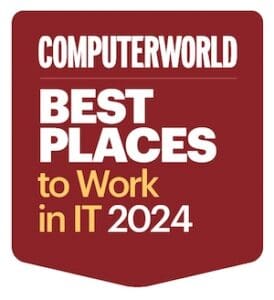(And other hilarious jokes)
Anyone who has made a purchase decision has gone through the occasional bad experience. Unfortunately, in the world of Information Technology (IT), missteps in buying products and services are not easily correctable, resulting in lost time and money.
Consumer Mindsets are Making Your IT Weak
Consumers have learned a lot about technology and often know only enough to be dangerous. Sadly, that knowledge and unearned swagger also create the perfect opportunity to be exploited, and those consumers are your employees.
A terrifying situation on the rise in today’s business culture is the self-declared “IT expert.” These self-declared experts are often referred to in many businesses because they know phrases others do not and then wreak havoc in companies that take years to fix. If you think this does not apply to you, ask yourself what the primary job of your default IT person is in your organization.
If your company hired them for a role other than IT, they were likely hand-raisers or just inherited the role.
This challenge continues as people try to architect a business IT infrastructure the same way they configure their homes. This leads to layers of cobbled together devices and “fixes” that were done by the brother-in-law of the owner years ago – then followed by changes made by the IT Intern you hired last summer because, “hey, …they’re an intern and cheap, and they can say ‘subnet.'”
Put simply, business IT environments are nearly always sub-par when developed from a consumer economic mindset.
How does this show up in a business? Ask these questions and see if any fit your situation:
● When pricing either IT services or investments, do you or someone on your team declare “that’s too expensive” when your only association is a price tag you saw on Amazon, in Best Buy or on a price comparison website?
● Do you ever use the words “we don’t need all that” when someone talks to you about IT security?
● Do you feel like “we’ll just hire an IT person” is the right answer? (As if anyone would staff a hospital with one doctor and think that covered all the specialty areas)
● Have you ever priced anything such as a network redesign, updated hardware, firewalls, etc. and thought, “I can get that cheaper at _________?”
● Have you ever gotten a quote for a project and then tried to replicate the recommendations yourself?
If that describes your business, how is that going for you?
Original Sins
Business IT is an interesting dilemma. It has become the ultimate “do IT yourself” area for many small-to-medium size businesses. Our daily interactions with technology have created a false sense of “I can do that.” Regardless of your normal process, you likely end up in a situation that looks a lot like this:
● “Can’t we do some of this ourselves?”
● Hunt down the most tech-savvy person in the business who will boldly say, “sure, I can do that for far less money.”
● Purchase from Best Buy, Amazon, even eBay, etc. and attempt to match the design from the quotes
● Implementation lags
● Over time, you eventually call someone to fix the attempt, which ultimately costs you at least the same as the original quote, but usually more
● Regardless of the outcome, you will still think you were over-charged
Stop Bad Behaviors
Consumer technology mindsets coming into the workplace are not the only things to manifest destructive buying behaviors for a business.
Some of the more common things that develop these behaviors actually “feel” like common sense:
● Organizational Misalignment: When companies do not have a full or part-time CIO or CTO, they often have IT report to the CFO. This is almost as big a mistake as having Marketing report to the CFO. For some reason, the person who is responsible for finance inherits the responsibility of IT. Maybe because these individuals are inherently good with spreadsheets and are usually more technically adept with making a printer or computer work, let’s reverse the logic, though. If an IT person is good with Excel, can they be your CFO? That is not a situation you want. Finance is an essential function in any organization, though it is NOT the optimal spot in your organization to control your IT. To place the responsibility there removes a healthy organizational tension necessary to create balance. Finance tends to view IT as an expense rather than an investment (like sales commissions are viewed as an expense rather than an incentive). If IT rolls into your CFO, move it somewhere else – quickly. You (and they) should be happier.
● Residual budget approach: Some organizations try to make IT a strategic advantage. They build a roadmap and invest in its achievement. Others create their budget, then relegate IT spend to whatever amount remains in the expense budget after funding every other area. In many organizations, IT is the second budget to be cut in challenging times (a close second to marketing). This purely reactive mode of IT planning creates significant risk and virtually guarantees a cybersecurity incident in the future will impact you. Whether you have in-house resources or use a technology partner, under-funding the effort is the primary reason for IT failures.
● Conference strategy: Some companies allow their IT direction to be influenced by the last conference their executives attended. Many have experienced “The Return.” That is the week after a conference when the senior executives return and blister the organization with “why are we not doing this?” and “we’re going to initiate these things.” Here’s an idea: an IT roadmap. Make your advancement through IT maturity predictable.
● “The world changed – why is my stuff not working?” Some have a mindset that IT investments are one-and-done. Consider, for example, that most networks were designed for email and some file transfer. 2020 taught everyone they should have tooled for video (which costs more money in configuration and equipment). This is much like the road you traveled today on your way to work. Most likely it gets orders of magnitude more cars than assumed when it was designed. Eventually, it will have to be widened, which is not free.
● Sacrificing security for convenience: Many technological conveniences are neutered by the security issue they create. However, businesses must acknowledge the growing burden to keep their systems, data and customer data secure. This means a rational acceptance that companies must discard some conveniences in the interest of security.
● Just teach our person to do it and we’ll handle it from there: This oddity really does not even warrant explanation. If you are truly willing to put your IT future, your data security and your ability to make appointments/make phone calls/process payments into the hands of someone who is “willing to do it if they get caught,” then you deserve whatever comes your way.
Over time, our grassroots impressions of IT start to become our reality. Just like Plato’s Cave, we begin to think the shadows are what the outside world looks like. A rational approach to buying IT demands a willingness to acknowledge the real status quo and acknowledge that a healthy IT framework costs more than what anyone thinks they should pay.
No matter where you are in your IT journey, remove from yourself the burden of feeling behind. Make today a new start with a fresh perspective. Technology in business is no longer a choice. Neither are the externalities that ride alongside technology. The most healthy buying process for technology starts with adjusting to a new mindset. Such a mindset leaves consumer buyer expectations behind and places a premium on reliability and security.
The very best companies develop their roadmap and a logical process for progressing on their technology journey. This can be done for any size business and requires strong leadership to lead your people into both a mindset and approach that leads to a more healthy IT infrastructure. This leadership must start at the top because you cannot lead somewhere where you are not prepared to go.
Download the E-book here:








